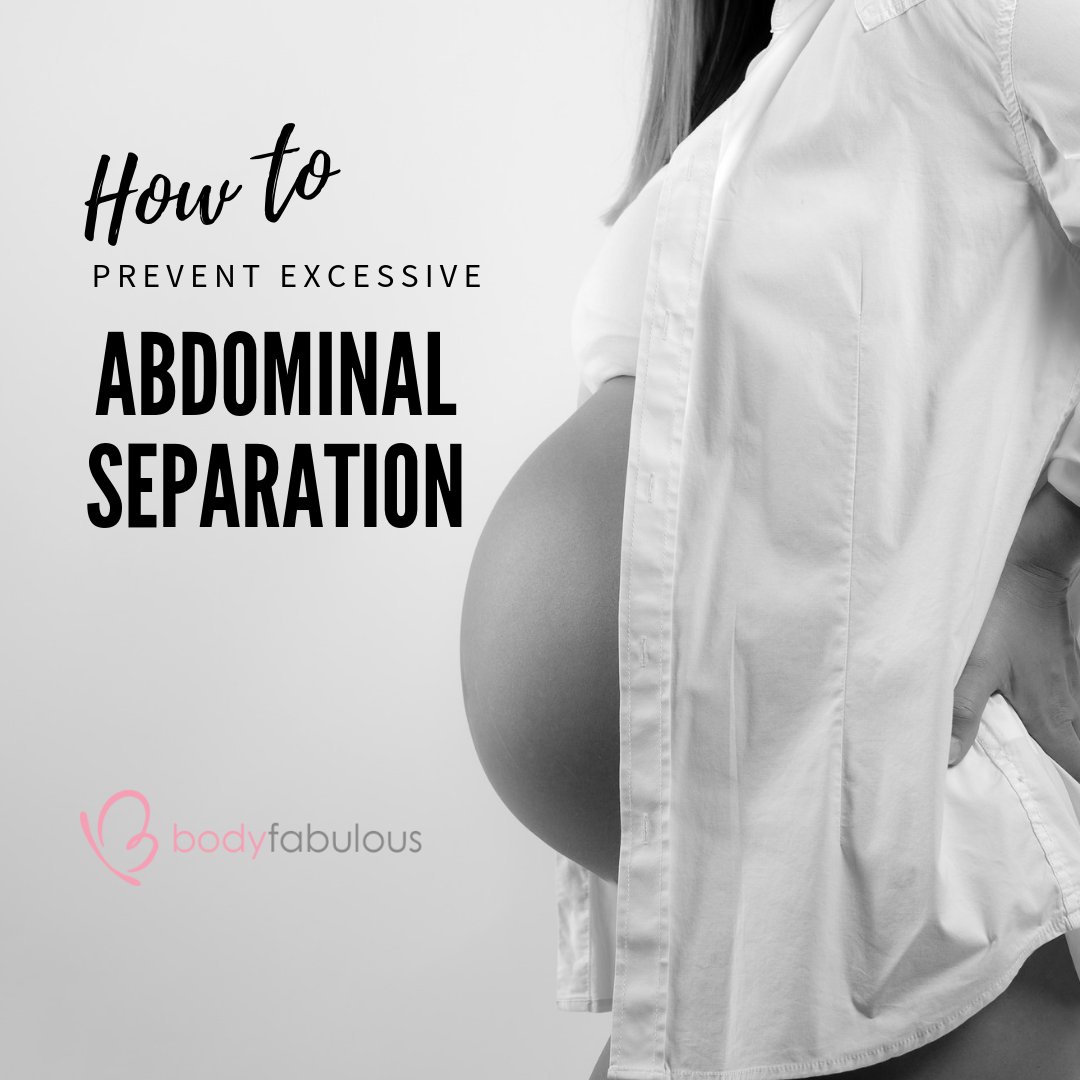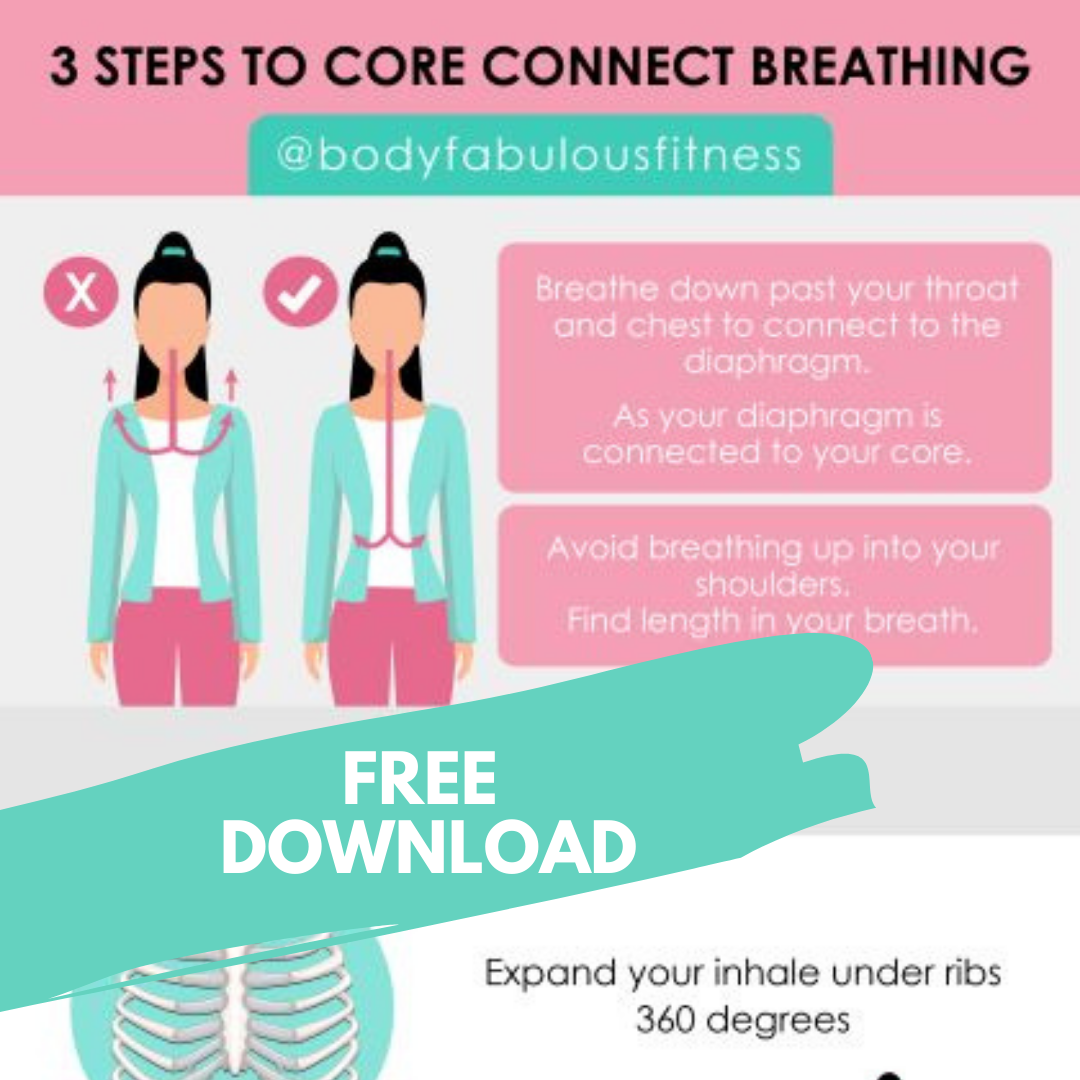Abdominal separation is a normal condition that occurs in pregnancy to allow for the growth of the baby and uterus. Most women will have some degree of separation or Diastasis Recti (DR) towards the end of a pregnancy. However it is the size and depth of the separation that can become problematic post birth if not managed correctly during pregnancy.
What is diastasis recti ?
Diastasis recti is a condition where the two right and left sides of the rectus abdominis (your “six-pack” muscle) spreads apart at the body’s mid-line (the linea alba). Separation occurs in response to your uterus pushing against the abdominal wall and pregnancy hormones which soften connective tissue. Separation can occur at any time in the last half of pregnancy but is most problematic after pregnancy when the abdominal wall is weak, when there is no longer a baby inside to aid support. Premature separation can also be seen as early as 20 weeks and most women will often not feel the separation occurring during pregnancy.
There are varying degrees of diastasis recti during pregnancy
About 30% of pregnant women experience abdominal separation that significantly reduces the integrity and functional strength of the abdominal wall and can aggravate lower back pain and pelvic instability. Abdominal Separation in a previous pregnancy significantly also increases the probability and severity, of diastatis recti in subsequent pregnancies. Women expecting more than one baby, petite women and those with a pronounced sway back, or with poor abdominal muscle tone are at greatest risk. Genetics also contributes to DR, for some women, it’s simply how their bodies respond to pregnancy.
How to reduce your diastasis recti
If you want to reduce your diastasis then it is important to address the things you do daily – or your functional movement. If you can start training your core safely during pregnancy safely – this will make a big difference to your postpartum recovery (and it’s not too late to start if you have given birth). Grab my complimentary CORE TRAINING GUIDE HERE.
Other factors to consider about Ab Separation are…
Poor posture that is maintained over numerous hours and days, during daily activities can contribute to the condition…be conscious of how you carry your toddler, handbag and how you sit daily at a desk. Also do these postural exercises while you breastfeed or nurse your baby – to help to “retrain” your core.
Your pelvic floor is also the foundation of your core so ensuring this muscle remains toned and functional during pregnancy will help your diastasis heal more effectively post birth. Safe and effective exercise during pregnancy plus, good nutrition and avoiding excess weight gain will also help to reduce separation.
Avoiding excessive abdominal separation, will also assist with effective healing post birth and reduce some of the issues associated with DR. Including complaints such as lower back and hip pain, poor posture, hernias, leaking (bladder control issues) and a “mummy tummy” or “pooch” that wont go away.
Non optimal exercise during pregnancy and postpartum
It is easy to avoid exercises that increase separation if we know what they are, if you are unsure please seek the advice of a certified pre/post natal trainer. Plus remember if it doesn’t feel right please don’t do it !
Generally these are exercises that should be avoided during pregnancy as they increase abdominal separation :
- Avoid all frontal planks on the swiss ball or on the floor.
- Full or kneeling press ups should be avoided during second and third trimesters and more suitable core strength exercises should be done.
- Avoid Crunches.
- Plus lifting incorrectly and holding the breathe where intra-abdominal pressure is excessively increased.
If you experience your abdominals “coning” or when ab muscles bulge during an exercise this is a signal that the exercise is causing too much stress on the abdominal wall, so it is best you avoid it.
But don’t stress….once you have healed effectively post birth these are definitely exercises you can work towards. When you are ready !
Please avoid planking during pregnancy.
You can heal many years post birth
Remember you are post natal forever, so it is possible to heal abdominal separation several years post birth. I personally have trained women who are 10+ years postnatal and they have noticed a big difference in their core strength, tummy appearance and posture ! Its never too late to make a change. Start here with this free download and videos.
I focus on specialised core/abdominal exercises to help to control DR and most importantly help to return the muscles to their pre-pregnancy position. Only occasionally do some women have such severe separations that require surgery and even in these cases the correct core exercises can significantly reduce the separation.
Your breath is key to re-activating your core correctly
Learning how to breathe and activate the four intrinsic core muscles (Diaphragm, Transverse Abdominus (TA), Pelvic Floor (PF) and Multifudus) correctly both during and beyond pregnancy will help to reduce separation during pregnancy and then aid healing post birth.
Breathing is important not only because we need do it all the time but we use our core muscles to breathe ! If we are not breathing and recruiting the core muscles sufficiently then the transverse abdominal muscles are not contracting optimally. Therefore incorrect breathing and core muscle activation will not assist to close a DR.
Learning to breathe and activate your core muscles precisely is therefore one of the first steps in the healing process. I go through breathing and correct core muscle activation in great detail all my sessions. Read more here.
Confused about Diastasis or Ab Separation ?
Unfortunately, hundreds of misconceptions swirl around diastasis recti and abdominal exercise during and after pregnancy in general. You’re likely to encounter a broad range of contradictory opinions and advice about how to recondition your abdominal wall and how to restore the midline after childbirth. Some of these assertions can cause unnecessary alarm, while another common piece of advice “just do lots of of sit ups” or “planks” can actually worsen abdominal separation.
Myths about abdominal separation and postnatal abdominal reconditioning:
- Diastasis recti/abdominal separation causes permanent damage to your abdomen.
- Diastasis recti/abdominal separation requires surgical repair.
- Diastasis recti/abdominal separation causes permanent bulging of the abdomen – “mummy-tummy.”
- Diastasis recti causes pain.
- I have a six pack, so I don’t have a dysfunctional core – wrong !
- The abdominal muscles will always be weaker after childbirth.
- You can’t train your core during pregnancy – you can, safely find out here !
- All women should wait for at least six weeks after delivery before beginning any abdominal exercises or postnatal reconditioning program.
These are all INCORRECT statements. Connect with me to discuss these further in my Facebook Community #BFABSQUAD

Consider consulting a certified pregnancy/ post natal trainer who can devise a specialised program for your recovery using some of these exercises. If you have been trying to heal your muscle separation for more than 12 months, have finished breastfeeding and your separation is not changing and you also find it hard to create any tension of the linea alba then you should see a Womens Health Physiotherapist for an ultra sound. An ultra sound will show you in detail if the connective tissue (linea alba) has stretched beyond healing with rehabilitation exercises, posture management and nutrition.
Recent research now also suggests that you do not have to close your separation completely for optimal function. What this means is that if you have good tension of your linea alba and your body is functioning without pain, leakage or any other symptom suggesting separation then your diastasis has healed – this is called functional diastatis. Separation of the abdominal muscle is no longer just about the width, this is not what is important. Instead we now focus on the strength and tension of the connective tissue – your linea alba and how this affects your functional movement. Find out about how to measure abdominal separation right here.
Then start healing and preventing your abdominal separation / diastasis, right now !
I have 2 Freebies for you…
- Grab my complimentary 20 page CORE TRAINING GUIDE suitable for pregnancy, postpartum and ALL stages of motherhood (with medical clearance to exercise)
- Download my infographic on Diastasis Recti Here
xx

About Dahlas
Dahlas Fletcher is one of Australia’s most respected and successful certified and experienced Pregnancy and Female Fitness Trainers. Her goal is to help you be the happiest, most fabulous version of yourself, inside and out.












